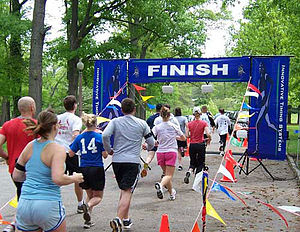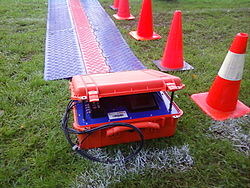- Transponder timing
-
 A Jaguar finish line with Jaguar (Innovative Timing Systems) which utilizes RFID technology through overhead antennas and passive, disposable chips.
A Jaguar finish line with Jaguar (Innovative Timing Systems) which utilizes RFID technology through overhead antennas and passive, disposable chips.
Transponder timing (also called chip timing or RFID timing) is a technique for measuring performance in sport events. A transponder working on a radio-frequency identification (RFID) basis is attached to the athlete and emits a unique code that is detected by radio receivers located at the strategic points in an event.
Prior to the use of this technology, races were either timed by hand (with operators pressing a stop-watch) or using video camera systems.
Contents
Transponder systems
Generically, there are two types of transponder timing systems; active and passive. An active transponder consists of a battery-powered transceiver, connected to the athlete, that emits its unique code when it is interrogated.
A passive transponder does not contain a power source inside the transponder. Instead, the transponder captures electromagnetic energy produced by a near-by exciter and utilizes that energy to emit its unique code.
In both systems, an antenna is placed at the start, finish, and in some cases, intermediate time points and is connected to a decoder. This decoder identifies the unique transponder code and calculates the exact time when the transponder passes a timing point. Some implementations of timing systems require the use of a mat on the ground at the timing points while other systems implement the timing points with vertically oriented portals.
History
The first manufacture to introduce transponder timing was AMB Identification & Timing, although it was in motorized racing. Since 1983, AMB active transponders are used in several motorized sports ranging from RC model car racing, high speed car racing, motocross, motor cycle racing, kart racing to snow cross. Since 1992 AMB transponders are also used in non motorized sports such as cycling, marathon, horse racing and triathlon.
Usage
As events draw very large numbers of participants (in some cases over 60,000 runners), there are delays in participants reaching the start line, which penalize their performance. Some races place antennas or timing mats at both the start line and the finish line, which allow the exact net time to be calculated. A controversy has developed as to whether awards in a race should be based on the "gun time" (which ignores any delay at the start) or "net time" (which subtracts the delay.) The USA Track and Field rules have decided that performance is based on "gun time." However, some races use "net time" for presenting age group awards.
When transponder timing was first introduced, the running community hoped for a universal standard, so that timing systems could operated interchangeably, with no overlap in chip serial numbers. However, race management companies have invested in incompatible systems, and individual runners who purchase a chip from one manufacturer find that the chip is not operable in races that use a competitor's equipment. The market share of the different, incompatible transponder systems vary in each local market, depending upon which system was adopted by the local clubs or timing companies.
As the cost of transponder tags have declined, the use of disposable tags has become more popular. The technology is the same as a reusable tag, but the race does not bother to collect and recycle the tags at the finish line. One manufacturer has developed a tag which is taped to a Tyvek strip, without a permanent glass or plastic form factor. The strip is then formed as a loop and laced to the running shoe. Another manufacturer has developed a tag that is taped to the runners race number. This has the added feature of increased accuracy in being recorded as the participant's torso crosses the finish line as opposed to the lead or trail foot, which sometimes leads to incorrect place results.
See also
- DAG System
- J-Chip Timing System
- ChampionChip
- RFID
External links
- DAG System
- SucaTiming
- Jaguar Chip Timing Systems
- MxTransponder USA
- Timing Technologies India
- Event Timing - Professional Timing & Results
- J-Chip Timing Systems
- MACSHA Cronos Timing Systems
- MYLAPS Sports Timing (previously AMB i.t. and ChampionChip)
- ChronoTrack Systems
- ChampionChip Home page
- Orbiter Timing Systems
- Indradhanush-Race timing solutions
- IPICO Sports
- Running USA article on transponder timing
- RFID Timing Systems
- Westhold Corporation
- Winning Time
- Watch the SOS Race timing, Biometrics, selective Video event
- AGNI-Timing sport timing services
Wikimedia Foundation. 2010.



